Vancouver Citation Style Guide (2nd ed.)
This piece of content has been developed by IvyPanda's editorial team.
No AI was involved in the creation process; only qualified experts contributed.
The information, facts, and sources presented in the text have been carefully checked and verified.
You are free to use it with proper referencing.
The Vancouver style is similar to the APA style in its popularity in the medical field. However, it is more complicated and has some rare features that you will rarely see elsewhere. The primary trait of the style is its use of a numbered reference list for citations. While the Vancouver style is not particularly complicated, you can make mistakes due to its unique nature. As such, we have prepared a guide to help you using our expertise and experience.
This guide is developed in line with Patrias K. Citing medicine: the NLM style guide for authors, editors, and publishers. 2nd ed. Wendling DL, technical editor. Bethesda (MD): National Library of Medicine (US); 2007.
What is Vancouver Citation Style?
The Vancouver style is generally used in physical sciences as well as medicine, for which it was created. It is somewhat unique in the fact that it is neither an in-text style nor a footnote-based one, though it borrows from both paradigms. Instead, the Vancouver style uses a numbered reference list and has you put only the number of the reference using either brackets or superscript in the sentence where the citation happens. The style is most similar to AMA, and the lack of a footnote or a more detailed in-text creates a considerable difference between them and other formats.
Why Cite Your Sources
The need to cite and reference correctly is the primary reason why so many citation styles have emerged throughout the world. The benefits of citing correctly, as well as the issues that may arise if you do not do so, are listed below:
- You acknowledge that your work is based on the findings of others and give credit where it’s due. In return, the sources make your conclusions more valid by providing a basis for your reasoning and letting the reader see your inspirations.
- You avoid plagiarism, which is a severe offense in most occupations that require professional writing skills, both academic and otherwise. In the worst-case scenario, plagiarists can be expelled from their university or college or fired from their job with a permanent mark on their record.
- You learn to conduct research, find credible sources, and understand their contents. A peer-reviewed scholarly article or a published scientific book warrants more attention than a website blog entry from an anonymous author.
- You make it easier for the reader to verify your claims by looking at the correct source. If you cite something incorrectly, it may end up referring the reader to a nonexistent document, creating doubt and confusion.
General Principles of Vancouver Formatting
Vancouver citation style is typically used in medicine and science. It uses a numerical system that helps the user to identify the sources utilized in the body of the paper by assigning them with unique numbers. These numbers take less space when compared to other types of citation and formatting and do not interrupt the flow of the text:
- Double spacing
- One-inch margins (1’’ or 2.54 cm)
- Arial or Times New Roman font, unless the instructions demand otherwise.
Vancouver Style Outline
There are 2 basic types of outlines for you to choose (unless your tutor gives you a template)
Simple outline (either alphanumeric or decimal)
Example of alphanumeric outline
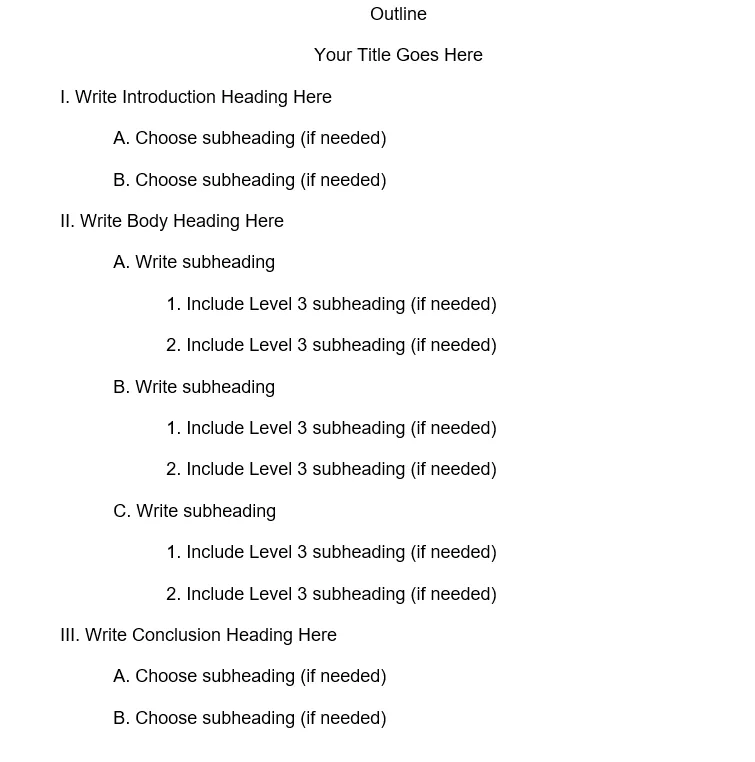
Example of decimal outline
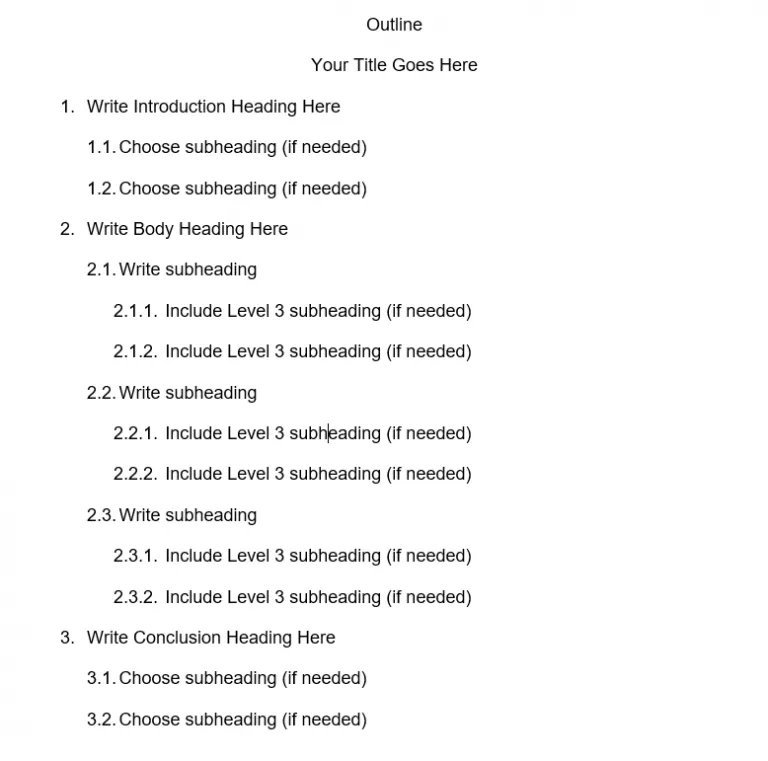
Example of full sentence outline
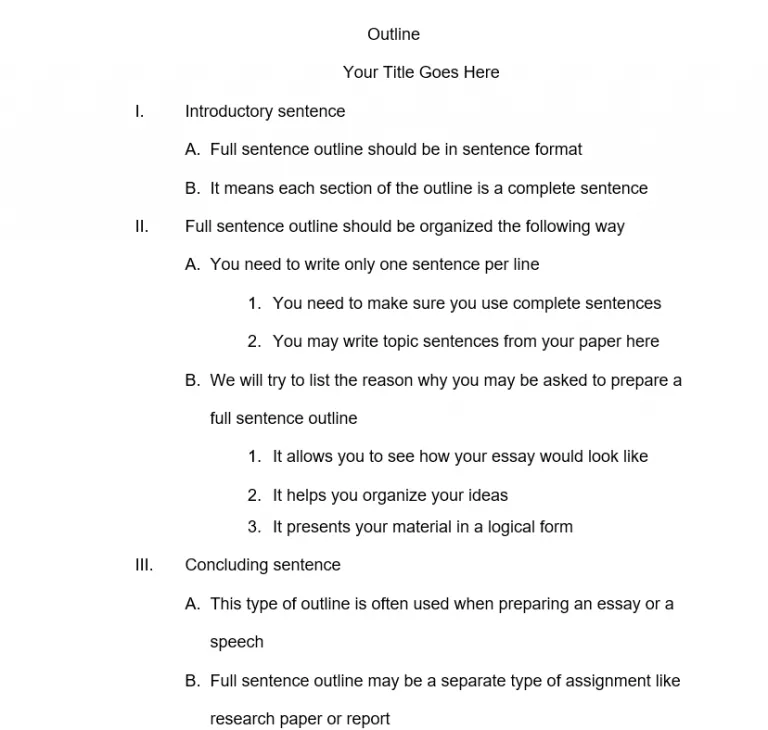
Vancouver Style Headings
- No specific rules for chapters, headings, and subheadings. The choice of these is left to the student. If they are used in the paper, their different levels must be clearly distinguished from one another. Different levels of subheadings must be identified by the position in the paper, the size of letters, and capitalization.
- Bold and larger fonts are recommended. Italics are to be used sparingly, as they are not as noticeable. The use of colored headings is forbidden. The use of capitalization and headings of the same level in the paper must be consistent.
Vancouver In-Text Citation Notes
- Numeric references are used in the text: either numbers in brackets (1) or superscript1 linked to citations in footnotes:
Jones (8) pointed out that …
Jones (8, p. 51) pointed out that …
Jones8 pointed out that …
Jones8 (p. 51) pointed out that …
- The same citation number is used whenever a source is cited in the text, they match numbered references for each publication in a reference list
- The type of in-text citations has to stay consistent throughout the entire body of the paper. Avoid using diverse types of in-text references.
- In sentences that contain more than one reference, each of the unique sources of information will have its own number: e.g., The study supports the idea that … (1), and another group of researchers has discovered that … (2).
- If several sources are cited at the same time, several numbers can be put in brackets or added in the form of superscript.
- If the sources cited together in one sentence have the sequential numbers, then they can be referenced using the following forms: (1-6) or 1-6.
- Full stops can be put before or after the superscript numbers or the numbers in brackets.
There are three variants of in-text citations that are used to cite medicine-related sources and that can be referred to in the Vancouver format:
- citation-sequence
- citation-name
- name-year
Citation-Sequence Example:
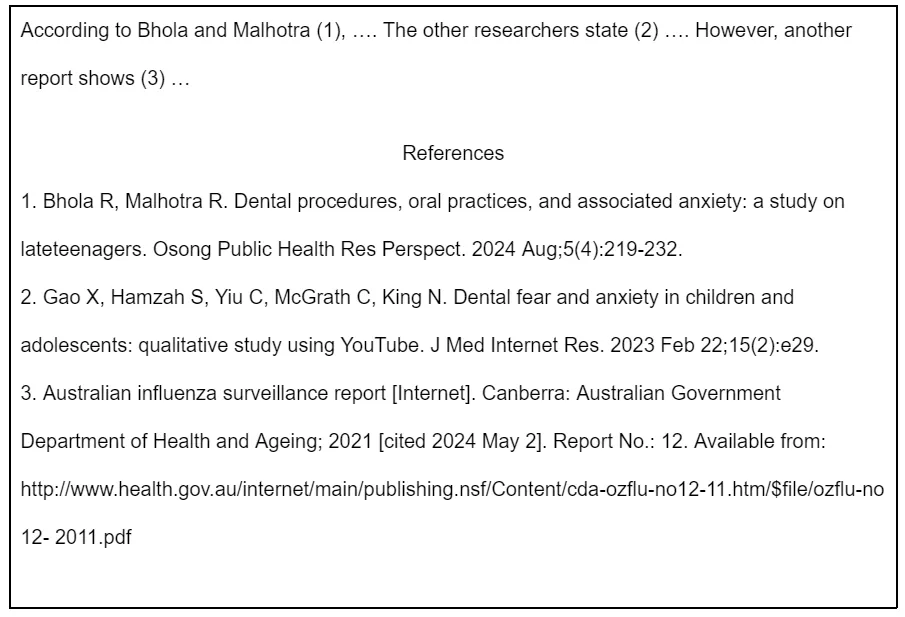
Citation-Name Example:
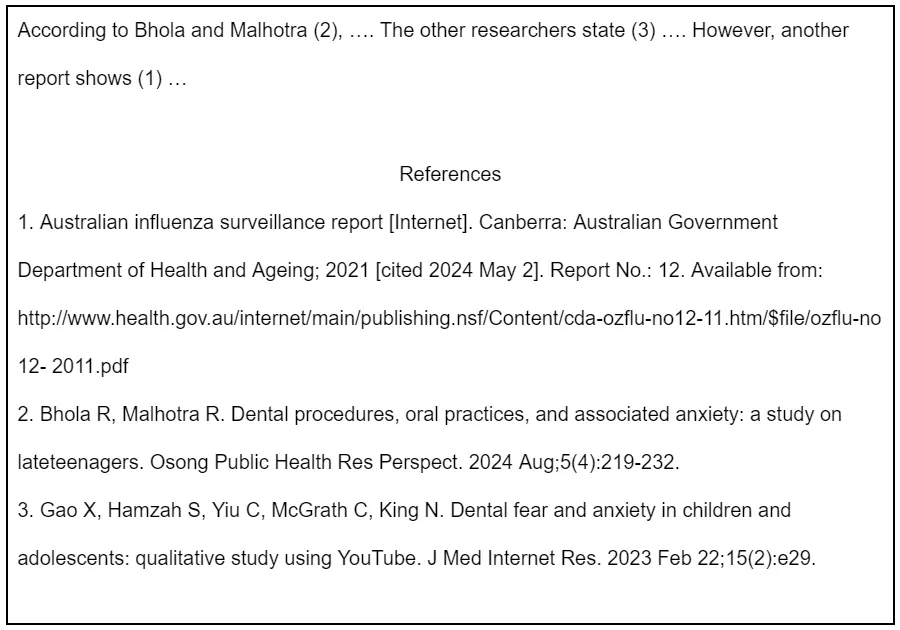
Name-Year Example:
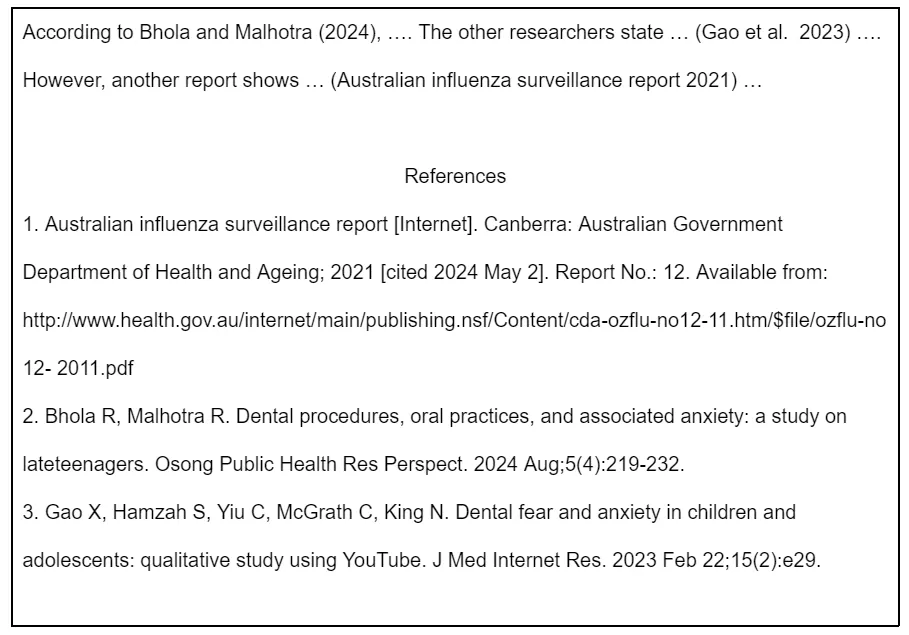
Vancouver Reference List Notes
- The reference list in Vancouver style should be titled as “References” and placed on a separate page at the end of the text.
- Only Arabic digits (1-9) can be used in order to enumerate the sources in the reference lists and provide citations.
- The reference list gives publications in the order they appeared in the text, not alphabetically.
- The numbers in the reference list must match those in the text if the citation-sequence or citation-name system is used.
- Each reference must start with a new line and follow the numerical order.
- No indentations are necessary in the Vancouver style.
- Only the first word in a title as well as proper names are to be capitalized.
Vancouver Referencing
Vancouver Citation Book
One author
1. Last Name Initials. Book title: subtitle. City (Country/State Abbreviation): Publisher; Year. total number of pages.
1. Drewett PL. Field archaeology: an introduction. Wymondham (England): UCL Press; 2024. 196 p.
- Follow cities in countries outside of the US and Canada with the name of the country, when the city is not well known or when cities in different locations have the same name, such as Cambridge (MA) and Cambridge (England). Place the country name in parentheses.
- Follow US and Canadian cities with the two-letter abbreviation for the state or province to avoid confusion when citing lesser known cities or when cities in different locations have the same name, such as Palm Springs (CA) and Palm Springs (FL). Place the state/province abbreviation in parentheses.
- If no place of publication can be found, but it can be reasonably inferred (e.g., Chicago as the place for a publication of the American Medical Association), place the city in square brackets, such as “[Chicago]”.
- If no place of publication can be found or inferred, use [place unknown].
- Provide the total number of pages on which the text of the book appears.
Two to three authors
2. Last Name Initials, Last Name Initials, Last Name Initials. Book title: subtitle. City (Country/State Abbreviation): Publisher; Year. total number of pages.
2. McNei AJ, Frey R, Embrechts P. Quantitative risk management: concepts, techniques and tools. Princeton (NJ): Princeton University Press; 2024. 720 p.
More than three authors
3. Last Name Initials, Last Name Initials, Last Name Initials, Last Name Initials. Book title: subtitle. City (Country/State Abbreviation): Publisher; Year. total number of pages.
or
3. Last Name Initials, Last Name Initials, Last Name Initials, et al. Book title: subtitle. City (Country/Code): Publisher; Year. total number of pages.
3. Covell D, Walker S, Hess PW, Siciliano J. Managing sports organizations: responsibility for performance. 3rd ed. Burlington (MA): Elsevier; 2023. 511 p.
or
3. Covell D, Walker S, Hess PW, et al. Managing sports organizations: responsibility for performance. 3rd ed. Burlington (MA): Elsevier; 2023. 511 p.
If there are space constraints, the number of listed authors may be shortened to the first three authors. After the last author, add a comma and “et al.”
Different editions
Structure:
4. Last Name Initials. Book title: subtitle. # ed. City (Country/State Abbreviation): Publisher; Year. total number of pages.
4. Feldman R. Understanding psychology. 11th ed. New York: McGraw-Hill; 2023. 800 p.
Unknown author
5. Book title: subtitle. City (Country/State Abbreviation): Publisher; Year. total number of pages.
5. Alluvial archaeology in Europe. 2nd ed. New York: Routledge; 2023. 313 p.
6. Merriam-Webster dictionary new edition. Springfield (MA): Merriam-Webster; 2024. 968 p.
This type of reference can be used in citing dictionaries as well as any books without authors.
Editor with no author
7. Last Name Initials, editor. Book title: subtitle. City (Country/State Abbreviation): Publisher; Year. total number of pages.
7. Bohr A, Memarzadeh K, editors. Artificial intelligence in healthcare. New York: Academic Press; 2020. 378 p.
Author with an editor
8. Last Name Initials. Book title: subtitle. Last Name Initials, editor. City (Country/State Abbreviation): Publisher; Year. total number of pages.
8. Howells WD. Their wedding journey. Reeves JK, editor. Bloomington (IN): Indiana University Press; 2023. 200 p.
Translated book
9. Last Name Initials. Book title: subtitle. Last Name Initials, translator; Last Name Initials, editor (if any). City (Country/State Abbreviation): Publisher; Year. total number of pages.
9. Homer. The Odyssey. Fagles R, translator; Knox B, editor. London: Penguin Books; 2023. 541 p.
Make sure to mention all contributors, such as translators, editors, co-authors, or illustrators if mentioned on the book’s cover page.
Corporate author
10. Organization Name. Book title: subtitle. City (Country/State Abbreviation): Publisher; Year. total number of pages.
10. World Health Organization. Research gaps and needs to optimize the use of assisted vaginal birth: technical brief. Geneva (Switzerland): WHO Press; 2023. 20 p.
- If the corporate author and publisher are the same, shorten the publisher. For example, “Institute of Chartered Accountants in Australia and New Zealand” – “Institute”.
- If there are several corporate authors, list them all and divide with a semicolon.
Chapter in an edited book
11. Last Name Initials. Book title: subtitle. # ed. City (Country/State AbbreviationCode): Publisher; Year. Chapter number, Title: subtitle; page range.
11. Riffenburgh RH. Statistics in medicine. 2nd ed. Amsterdam (Netherlands): Elsevier Academic Press; c2020. Chapter 24, Regression and correlation methods; p. 448-90.
If no date of publication can be found, use the date of copyright preceded by the letter “c”,: for example: c2023.
Book found online
12. Last Name Initials. Book title: subtitle [Internet]. City (Country/State Abbreviation): Publisher; Year [cited Year Mon Date]. total number of pages. Available from: URL
12. DeLaune SC, Ladner PK. Fundamentals of nursing: standards and practice [Internet].Clifton Park (NY): Cengage Learning; 2024 [cited 2024 May 12]. 438 p. Available from: https://repository.poltekkes-kaltim.ac.id/606/1/Fundamentals%20of%20Nursing_%20Standards%20and%20Practice%20(%20PDFDrive.com%20).pdf
Vancouver Citation Article in Periodicals
Journal article
1. Last Name Initials. Article title. Periodical Title Abbreviation. Year Mon;volume(issue):pages.
1. Iacobellis G. Epicardial adipose tissue in contemporary cardiology. Nat Rev Cardiol. 2022 Sep;19(9):593-606.
- Journal titles are abbreviated: e.g., Nature Reviews Cardiology – Nat Rev Cardiol.
- Articles, conjunctions, and prepositions must be omitted.
- End date information with a semicolon unless there is no volume or issue, then end with a colon.
- The shortened month (Jan, Feb, Mar, Apr, May, Jun, Jul, Aug, Sep, Oct, Nov, Dec) and the day of the month or the season may be omitted if the journal is continuously paginated throughout the volume. However, the month and the day of the month or the season must be included when citing a journal that has no volume or issue number.
- If space is a consideration, the number of authors may be limited to a specific number, such as the first three authors. Follow the last named author by a comma and “et al.” or “and others.
2. Last Name Initials, Last Name Initials, Last Name Initials, Last Name Initials, Last Name Initials, Last Name Initials, Last Name Initials, Last Name Initials. Article title. Periodical Title Abbreviation. Year Mon;volume(issue):pages.
or
2. Last Name Initials, Last Name Initials, Last Name Initials, et al. Article title. Periodical Title Abbreviation. Year Mon;volume(issue):pages.
2. Melville JL, Reed SD, Russo J, Croicu CA, Ludman E, LaRocco-Cockburn A, Katon W. Improving care for depression in obstetrics and gynecology: a randomized controlled trial. Obstet Gynecol. 2024 Jun;123(6):1237–1246.
or
2. Melville JL, Reed SD, Russo J, et al. Improving care for depression in obstetrics and gynecology: a randomized controlled trial. Obstet Gynecol. 2024 Jun;123(6):1237–1246.
Journal article (no author)
3. Article title. Periodical Title Abbreviation. Year Mon;volume(issue):pages.
3. Care in diabetes—2022. Diabetes Care. 2022 Jan 1;45:S17.
- The abbreviation of the short journal title Diabetes Care is Diabetes Care.
- In this example, the year, month, and day are known: 2022 Jan 1.
Online journal article with doi
4. Last Name Initials. Article title. Periodical Title Abbreviation. Year Mon;volume(issue):pages. doi
4. Last Name Initials. Article title. Periodical Title Abbreviation [Internet]. Year Mon [cited Year Mon Date];volume(issue):pages. Available from: URL doi
4. Klein S, Gastaldelli A, Yki-Järvinen H, et al. Why does obesity cause diabetes? Cell Metab. 2022 Jan 4;34(1):11-20. doi:10.1016/j.cmet.2021.12.012
4. Klein S, Gastaldelli A, Yki-Järvinen H, et al. Why does obesity cause diabetes? Cell Metab [Internet]. 2022 Jan [cited 2024 May 16];34(1):11-20. Available from: https://www.cell.com/cell-metabolism/pdf/S1550-4131(21)00631-8.pdf doi:10.1016/j.cmet.2021.12.012
- For print articles with doi, follow the first example.
- For online articles with doi, the second example is preferable, where both the site and doi are mentioned.
Online journal article without doi
5. Last Name Initials. Article title. Periodical Title Abbreviation [Internet]. Year Mon Date [cited Year Mon Date];volume(issue):pages. Available from: URL
5. Banday MZ, Sameer AS, Nissar S. Pathophysiology of diabetes: an overview. Avicenna J Med [Internet]. 2020 Oct 2 [cited 2024 May 16];10(04):[15 p.]. Available from: https://www.thieme-connect.com/products/ejournals/html/10.4103/ajm.ajm_53_20
- If no pages are mentioned in the article, state the approximate number of pages in square brackets [# p.], [about # screens], or [# paragraphs].
- If no volume and issue are available, state pages after a colon. For example, 2023 [cited 2024 Jan 5]:[about 5 p.].
Magazine article in print
6. Last Name Initials. Article title. Periodical Title. Year Mon;volume:pages.
6. Neeson J. The dangers of Tiktok that are worth your attention. Reader’s Digest. 2020 Aug;6:3-10.
Do not abbreviate magazine titles.
Online magazine article
7. Last Name Initials. Article title. Periodical Title [Internet]. Year Mon [cited Year Mon Date];volume:pages. Available from: URL
7. Milne V. Why am I always tired? Reader’s Digest [Internet]. 2021 Apr [cited 2024 May 16];4:[about 5 p.]. Available from: https://www.pressreader.com/canada/readers-digest-canada/20210401/281496458992013/textview
Newspaper article in print
8. Last Name Initials. Article title. Periodical Title (Edition). Year Mon Date;Section:page (column on which the article begins).
8. Rabin RC. Medical care alone won’t halt the spread of diabetes, scientists say. The New York Times (National Ed.). 2022 Oct 5;Sect. A:4 (col. 2).
- Do not abbreviate newspaper titles.
- Section information replaces volume(issue).
- Add the page number on which an article begins.
- Add the number of the column on which an article begins.
Online newspaper / magazine article
9. Last Name Initials. Article title. Periodical Title [Internet]. Year Mon Date [cited Year Mon Date];Section:[# pages/screens]. Available from: URL
9. Rabin RC. Medical care alone won’t halt the spread of diabetes, scientists say. The New York Times [Internet]. 2022 Oct 5 [cited 2024 Apr 18];Sect. A:[about 6 p.]. Available from: https://www.nytimes.com/2022/10/05/health/diabetes-prevention-diet.html
Vancouver Citation Conference Papers
Full conference proceedings
10. Last Name Initials, editor. Conference Title. Proceedings of the Conference; Year Mon Date; University, City, State. City of publication: Publisher; Year. total number of pages.
10. Neta G, Chambers DA, Simpson L, editors. Proceedings from the 12th Annual Conference on the Science of Dissemination and Implementation; 2020 Dec 4-6; Arlington University, Arlington, the USA. Arlington (VA): Arlington Publishing; 2020. 112 p.
Capitalize all the significant words in the title of the conference (i.e., do not capitalize articles, conjunctions, and prepositions)
Paper from a published conference proceedings
11. Last Name Initials. Paper title. In: Last Name Initials, editor(s). Conference Title; Year Mon Date; City, Country. City of publication: Publisher; Year. pages.
11. Tran CK, Tseng CD, Lee TF. Improving the face recognition accuracy under varying illumination conditions for local binary patterns and local ternary patterns based on Weber-Face and singular value decomposition. In: The Institute of Electrical and Electronics Engineers, editor. 3rd International Conference on Green Technology and Sustainable Development (GTSD) Conference Proceedings; 2023 Nov 24-25; Kaohsiung, Taiwan: Conference Publishing Services; 2023. p. 5-9.
Paper from conference proceedings available online
12. Last Name Initials. Paper title. In: Last Name Initials, editor. Conference Title; Year Mon Date; City, Country. Place of publication: Publisher [Internet]; Year [cited Year Mon Date]. pages. Available from: URL
12. Tran CK, Tseng CD, Lee TF. Improving the face recognition accuracy under varying illumination conditions for local binary patterns and local ternary patterns based on Weber-Face and singular value decomposition. In: The Institute of Electrical and Electronics Engineers, editor. 3rd International Conference on Green Technology and Sustainable Development (GTSD) Conference Proceedings; 2023 Nov 24-25; Kaohsiung, Taiwan: Conference Publishing Services [Internet]; 2023 [cited 2024 May 20]. p. 5-9. Available from: https://ieeexplore.ieee.org/document/7796605
Vancouver Dissertation and Thesis Citation
Dissertation/thesis in print
1. Last Name Initials. Dissertation/thesis title: subtitle [degree statement]. City (Country/Code): Publisher; Year. total number of pages.
1. Murillo AB. The acquisition of acoustic and aerodynamic patterns of coarticulation in second and heritage languages [dissertation]. Urbana (IL): University of Illinois Urbana-Champaign; 2022. 112 p.
In the Vancouver referencing style, “dissertation” is used for a PhD submission, while “thesis” is used for a Master’s submission.
Although the format is similar to that of a book citation, the type of work must be referenced in square brackets at the end of the title. It could be [PhD thesis] or [dissertation];
The city and the country code should be placed in squared bracketsif the place of publication is not mentioned in the work. [Calgary (AB)]: University of Calgary;
If the dissertation was published, the place of publication must also be named. Typically, it is the same university where the dissertation was defended.
Online dissertation/thesis
2. Last Name Initials. Dissertation/thesis title: subtitle [degree statement on the Internet]. City (Country/Code): Publisher; Year [cited Year Mon Date]. total number of pages. Available from: URL
2. Murillo AB. The acquisition of acoustic and aerodynamic patterns of coarticulation in second and heritage languages [dissertation on the Internet]. Urbana (IL): University of Illinois Urbana-Champaign; 2022 [cited 2024 Apr 21]. 112 p. Available from: https://www.proquest.com/docview/2910370950
Lecture/Slides
3. Last Name Initials. Lecture title [lecture notes]. Place of publication: Publisher/University; Course Number: Title; Year Mon Date [cited Year Mon Date]. Available from: URL
3. Brown T. Theatre procedures [lecture notes]. Newcastle: Northumbria University; DE816: BSc Design; 2021 Feb. 4 [cited 2021 Mar 3]. Available from: https://sts.northumbria.ac.uk/
Vancouver Website Citation
Document on World Wide Web
1. Last Name Initials/Organization. Document title [Internet]. Place of publication: Publisher; Year Mon Date [updated Year Mon Date; cited Year Mon Date]. Available from: URL
1. Amba Health Centre and Hospital. AHC diabetes [Internet]. Gandhinagar (India): AHCH; 2023 Jan 1 [cited 2024 Apr 30]. Available from: https://ahchospital.org/images/diabetes–brochure-(-english).pdf
Dates of publication and updating content are often unknown for online resources. Always state the date of citing the material [cited 2024 Jan 1] and other available dates.
Document on World Wide Web (no author)
2. Document title [Internet]. Place of publication: Publisher; Year [cited Year Mon Date]. Available from: URL
2. Diabetes – symptoms and causes [Internet]. Rochester (MN): Mayo Clinic; 2024 [cited 2024 Apr 30]. Available from: https://www.mayoclinic.org/diseases-conditions/diabetes/symptoms-causes/syc-20371444
Blog
3. Blog Name [blog on the Internet]. Place of registration (Country/State code): Company; Year – [cited Year Mon Date]. Available from: URL
4. Last Name Initials. Blog post title [Internet]. Place of registration: Company; Year – [cited Year Mon Date]. Available from: URL
3. KidneyNotes.com [blog on the Internet]. New York (NY): KidneyNotes; c2006 – [cited 2024 May 16]. Available from: http://www.kidneynotes.com/
4. Cohen MH. CAMLAW: complementary and alternative medicine law blog [Internet]. Cambridge (MA): Michael H. Cohen, Esq; c2007 – [cited 2024 May 16]. Available from: http:// www.camlawblog.com/
- Mention the beginning date of the blog and add a hyphen and 3 spaces.
- You may add the type of the content in square brackets: [blog on the Internet].
Image, Figure or Table
3. Last Name Initials. Site title [Internet]. Year Mon Date [cited Year Mon Date]; Table/image/figure number and title; [number of screens]. Available from: URL
3. Hossain MA. Bangladesh Meteorological Department [Internet]. 2021 May 10 [cited 2024 May 10]; Table 1, Weather forecast valid for 24 hours commencing 06 PM today; [1 screen]. Available from: https://live4.bmd.gov.bd/p/WeatherForecast/
Social Media
4. Last Name Initials/Organization [@username]. Post title [Internet]. Year Mon Date [cited Year Mon Date]. Available from: URL
4. Confederation of Indian Industry [@CII]. Did you know by 2035 AI is expected to boost India’s annual growth rate by 1.3%? [Internet]. 2021 May 4 [cited 2024 Apr 23]. Available from: https://www.facebook.com/FollowCII/2posts/4389646397736448
Film
Film title [motion picture]. City (Country/State): Publisher; Year.
Men to find [motion picture]. New York: Universal Studios; 2020.
Tables and Figures in Vancouver Style
The Vancouver citation style treats tables and images similarly to other reference types, requiring that the object has an appropriate entry in the bibliography. There are no restrictions on the specific presentation of an image or table, though there is an example provided in this guide in figure (1). In general, you should follow basic guidelines that apply regardless of the specific style used, such as referring to figures and tables directly via parentheses.

Figure 1. Glass world (1).
When citing a figure or table that comes from a print source, you have to include a full reference in the bibliography. First, cite the work itself as usual, including all of the information that would go into such an entry. Next, identify the object via the designation used for it in the original paper.
Provide the number, the caption, and the page on which the table or figure may be found. If there is no caption, create one yourself based on what you think would be appropriate. With online sources, you can reference the items directly, and there is generally no paging, so the referencing becomes easier. With that said, print sources are typically seen as more credible than online ones, so you should be careful about balancing difficulty and quality.
Reference List
1. Glass world [Internet]. 2020. [cited 2024 Feb 12]; Image 1; [1 screen]. Available from: https://www.environmentalscience.org/wp-content/uploads/2016/09/NEPA-CEQA-640×425.jpeg